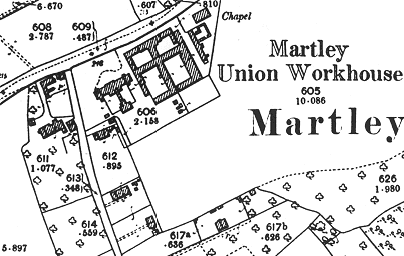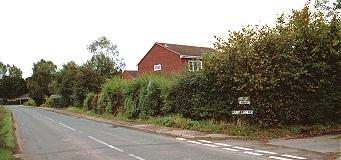Martley, Worcestershire
Up to 1834
Hallow had a workhouse from around 1800 located at the north side of what is now Parkfield Lane, then known as Workhouse Lane. Other parishes making use of the workhouse included Claines, Warndon and Winchenford. Local records list the following amongst the workhouse's inmates who included the elderly homeless, and single mothers and their children:
| 1820 | Thomas (labourer) and Elizabeth Patrick and daughter Louisa (see 1836 entry below) |
| 1823 | Sarah Berry and her son Samuel |
| 1824 | Jane and her daughter Harriett |
| 1825 | Sarah Brooks and son William |
| 1829 | William and Sarah Hooper, daughter Emma - paupers |
| 1830 | Ann Herbert and son Thomas (from Claines Parish) |
| 1836 | Louisa Patrick and son William; Eliza Thomas and daughter Helen |
A charity in the parish of Leigh with Bransford is recorded as including 'a dwelling-house, formerly the workhouse'.
There was also a parish workhouse in operation at Astley.
After 1834
Martley Poor Law Union was officially formed on 8th October 1836. Its operation was overseen by an elected Board of Guardians, 31 in number, representing its 28 constituent parishes as listed below (figures in brackets indicate numbers of Guardians if more than one):
County of Worcester:
Abberley, Alfrick, King's Areley, Astley, Bransford, Broadwas, Clifton upon Teme, Cotheridge, Doddenham, Great Witley, Grimley, Hallow (2), Hillhampton, Holt, Knightwick, Leigh (2), Little Witley, Lulsley, Martley (2), North Hallow, Pensax, Shelsley Beauchamp, King's Shelsley [Shelsley Kings], Shelsley Walsh, Shrawley, Stanford on Teme, Stockton on Teme, Suckley, Wichenford.
Later Additions: Malvern Link (1837-99), Kenswick(from 1861), Lower Sapey (from 1895).
The population falling within the union at the 1831 census had been 13,093 with parishes ranging in size from Shelsey Walsh (population 45) to Leigh (1,673). The average annual poor-rate expenditure for the period 1834-36 had been £5,520 or 8s.5d. per head of the population.
After the formation of the Martley union, the workhouses at Hallow and Astley initially continued in operation, with the construction on a new union workhouse at Martley commencing in the summer of 1837. In June, 1838, the union advertised for a workhouse master and matron who were to reside at Hallow workhouse until the new building was completed, and also attend at the Astley workhouse. The Hallow workhouse was closed a few months later. The building was demolished in 1880 to make way for the Wheeley Lea estate laundry, now converted to private houses.
The new union workhouse opened in the autumn of 1838. The Commissioners authorized an expenditure of £3,798 on construction of the building which was to accommodate up to 150 inmates. It was designed by Sampson Kempthorne who was the architect of many other early Union workhouses including ones at Droitwich, Pershore, and Upton-upon-Severn. Martley workhouse was based on his model "200-pauper" plan, published by the Poor Law Commissioners in 1836, which had a cruciform layout but without a central supervisory hub. Its location and layout are shown of the 1902 map below.

Martley workhouse site, 1902.
The entrance block at the north contained the Guardians' board-room and Porter's office at the centre, with offices and the girls' day room at the east, and the bakehouse and boys' day room at the west. The schoolroom lay in the short range at the centre rear. The central cross-wing contained the Master's quarters and kitchens at its centre, with women's accommodation at the west and men's at the east. The dining-hall lay south of the centre and connected to the southern range which contained receiving wards, mortuary, refractory cell and store. A separate infirmary was added at the west of the workhouse and a chapel at the east. The structure at the east of the main block was a vagrants' ward and labour yard.
In 1901, a scandal hit the Martley workhouse when the Master and Matron were charged with drunkenness leading to demands for a Government Inquiry. A special meeting of the Martley Board of Guardians was held, to which newspaper reporters were admitted for the first time ever, such was the seriousness of the matters under discussion. The Guardians were told of the deeply disturbing state of affairs discovered when an inspector paid a surprise visit to the Workhouse. The Master and Matron, Mr and Mrs Battersea, were not present, and the inspector learned that inmates frequently went out of the workhouse without permission to visit public houses in the area. One inmate confessed that he had just returned from a pub with two pennyworth of gin. The inspector heard that inmates were regularly to be found drunk in the workhouse itself but, worse still, staff disclosed instances of the Master and Matron being guilty of "intemperance". In addition, the workhouse children were ill-clothed and often dirty, paupers' food and Christmas fare had been withdrawn, and meals in general were not good enough and poor in content.
The Master and Matron, who had held their posts for 21 years, gave an explanation for their absence on the day of the inspector's visit. They had travelled into Worcester to arrange a concert at the workhouse, but several of the performers they wished to book were providing the entertainment at a Masonic banquet. While they waited for them until late evening, they decided to visit the Theatre Royal the first time they had attended a "place of amusement" in 10 years.
After 1930, the workhouse became a Public Assistance Institution, later known as Red House, and provided care for the elderly and chronic sick. The old buildings have now been demolished and a housing development now stands on the site.

Martley, 2000.
© Peter Higginbotham.
Staff
Inmates
Records
Note: many repositories impose a closure period of up to 100 years for records identifying individuals. Before travelling a long distance, always check that the records you want to consult will be available.
- Worcestershire Archive and Archaeology Service, The Hive, Sawmill Walk, The Butts, Worcester, WR1 3PB. Few records survive. Holdings include Guardians' minute books (1863-1917, 1926-30).
Bibliography
- Higginbotham, Peter The Workhouse Encyclopedia (2014, The History Press)
Links
- Photos and plan of Martley workhouse at www.martley.org.uk
Acknowledgement
- Thanks to Joy Fulcher for information on the Hallow workhouse.
Unless otherwise indicated, this page () is copyright Peter Higginbotham. Contents may not be reproduced without permission.


